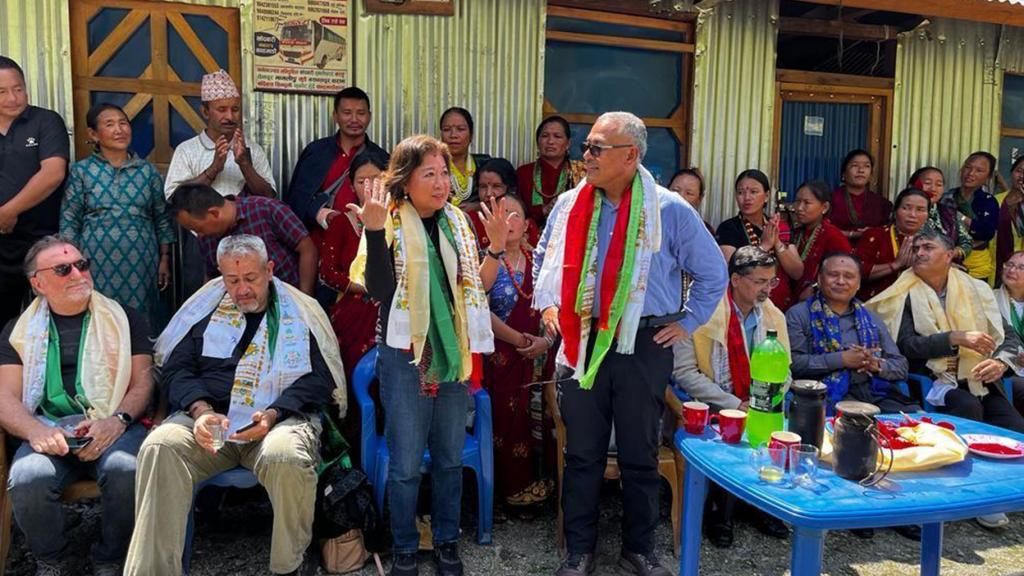World Bank’s Mari Pangestu: Time to walk the walk on mainstreaming gender in decision making
The gap between theory and practice of gender mainstreaming in policy-making remains wide even though the concept has been around for decades. Jennifer Freedman, managing editor of IISD’s Trade and Sustainability Review, interviews Mari Pangestu of the World Bank about the importance of mainstreaming gender in decision making.
There’s no shortage of rhetoric about the need to ensure that a gender perspective is integrated into decision making so policies consider the interests and concerns of both women and men. But while the concept has been around for decades, the gap between the theory and practice of gender mainstreaming remains wide.

Although progress has been made, “we need to keep pushing,” says Mari Pangestu, managing director of development policy and partnerships at the World Bank.
“We talk about mainstreaming gender in decision making, but it really needs to be done,” she said in an interview. “Policy-makers must have gender sensitivity and make sure women are at the table when they make policy decisions.”
As the world emerges from the COVID-19 crisis, it’s more crucial than ever to empower women entrepreneurs—whom Pangestu calls the key to an inclusive recovery.
The global labour force participation rate for women is just 53%, compared to 80% for men. “We need to improve this by having formal and informal institutions be more gender equitable,” she says. “Laws and regulations—along with enforcement and implementation of those regulations—must ensure that women can participate equally in the labour force.”
“Policy-makers must have gender sensitivity and make sure women are at the table when they make policy decisions.”
But how to persuade governments that mainstreaming gender is valuable? “Make the economic argument,” Pangestu says. “If you are wasting half of your human capital, we can translate that into how much growth you’re actually losing out on. The higher the participation, the more productive the labour force and the higher the growth. Women also save and invest in their children’s education and that helps to reduce poverty.”
Countries are seeing the benefits of promoting gender equality and helping women enter the labour force. For example, Saudi Arabia has taken a series of steps to boost women’s participation in economic activities and put in place legal reforms in areas such as pensions, pay, and entrepreneurship. According to the World Bank’s Women Business and the Law index, for the first time, the country now scores above the global average on legal reforms to enhance women’s economic rights.
And other countries have noticed.
“Women’s involvement in Saudi Arabia went from 20% to 30%, and neighbours saw what was happening and they started to do the same things,” Pangestu says. “But it’s not just the regulations and legislation; you have to shift the cultural and social norms as well. It’s a process—it’s about the economic and other benefits.”
Childcare—or the lack of it—is “a major barrier to women’s labour force participation,” according to Pangestu. The type of work mothers can do is also limited because they must care for their children. The International Labour Organization estimates that more than 600 million women are unable to enter the workforce because of childcare obligations.
One of Pangestu’s duties as Indonesia’s trade minister from 2004 to 2011 was revitalizing public marketplaces. While the focus was on physical infrastructure, such as improving roofs, she found during her many visits to these markets that women were the majority among workers, many with children. “I said this is not right, and we did a lot of observation on how to make it easier for women,” she recalls. “We added childcare facilities at all the markets and we redesigned the bathrooms so they were equipped for women and breastfeeding. The women pay for these services.”
Pangestu is particularly sensitive to the needs of women—and the challenges they face—because of her own experiences in breaking down barriers in Indonesia’s bureaucracy. She is the first female Indonesian of Chinese descent to hold a cabinet position in the Southeast Asian country, and a Catholic in a Muslim-majority country. Her career path hasn’t been easy.
“As a woman and as a minority, you have to double-proof yourself, you have to show that you can perform the job."
“As a woman and as a minority, you have to double-proof yourself,” Pangestu explains. “You have to show that you can perform the job. The standards are higher than for men, and we are watched to see if we can do it. I’ve had many experiences in my career in that vein. You’re there to pave the way for other women.”
Pangestu says she couldn’t have done it without the help of mentors who guided her with honest (if sometimes harsh) feedback about her work performance and a network of contacts who had their ears to the ground. “To be the first of whatever, to help and support me to be successful, I needed feedback in real time,” she said.
Rethinking Global Value Chains Amid a Pandemic and a War
Like the economic empowerment of women, participation in global value chains is also key to the world’s recovery from the pandemic and its ability to withstand the ripple effects of the Russia–Ukraine war, Pangestu says. The conflict has triggered turmoil in commodity and financial markets, reshaped international energy costs, fuelled uncertainty about the recovery of the global economy, and aggravated food security across the planet.
“There was a lot of disruption during the pandemic on value chains and that led to a questioning of the value of value chains,” she says. “But research shows that being part of global value chains increases your resilience to shocks. We thought about global value chains for efficiency purposes, but with the pandemic and now the war in Ukraine, we need to balance that with resilience and security concerns.”
Participating in global value chains has helped many countries, especially developing economies, weather and rebound more quickly from the pandemic. Greater resilience means more import diversification—sourcing inputs including oil and gas, microchips, certain minerals, and fertilizers from more markets—and also diversifying export markets. This is good news for developing countries, Pangestu says.
“Big countries are looking to diversify, so in areas like garments or textiles, which are labour-intensive, we’re going to see more regional value chains rather than global value chains. That opens up opportunities for African countries to enter the more labour-intensive part of global value chains because of proximity and also because a lot of African countries have preferential free trade access to Europe and the United States. This is also true for some Latin American and Caribbean countries, but they must work on their policy, trade finance, trade facilitation, and other things—they need to get their house in order.”
East Asia is already diversifying away from China, partly because of trade tensions between Beijing and Washington but also because costs in China have been rising. “There is already movement to Vietnam and other parts of Asia, and that’s going to continue, also in Southeast and South Asia,” Pangestu predicts. “But it’s not just about labour costs; if you want to increase the value added, you have got to invest in training workers as well.”
Policy-makers must also aim for inclusivity to broaden the benefits of trade, she says. This means removing barriers to labour mobility between sectors and domestically.
“The negative impact of a region which is less competitive can be long-lasting because these people cannot move to the region or the sector where the comparative advantage is booming. We need policies that allow physical and labour mobility from lagging sectors to growing sectors. This is partly a connectivity issue, but it also means retraining and educating workers.”
Women traders in particular must be educated on how to export and deal with the related paperwork and border regulations and procedures, Pangestu says. Policy-makers in developing countries also need to tackle tariffs in sectors that employ a lot of women, such as farming and textiles. These so-called pink tariffs are 6% higher than in male-dominated sectors.
Trade Restrictions Are Not the Answer to Food Inflation
Pangestu has more advice for policy-makers: stop hobbling trade with measures such as export curbs.
Today, more than 6 months into the Ukraine–Russia war that has crimped exports of fertilizers and commodities such as wheat, barley, sunflower oil, and corn, export restrictions are driving food prices even higher. While the price of wheat—a staple in many developing countries—has dropped from its March peak, around three dozen governments have curbed food and fertilizer exports in a bid to tackle inflation.
They are doing just the opposite, Pangestu argues.
“Exporting countries should refrain from stockpiling and export bans or taxes as a response to rising food and fertilizer prices, as that will worsen or prolong the challenge globally,” she says. “If restrictions are imposed, they should at least be time-bound, transparent, targeted, and consistent with [World Trade Organization] rules and account for the impact on other countries, especially least developed countries.”
Pangestu has more advice for policy-makers: stop hobbling trade with measures such as export curbs.
Importing countries, on the other hand, “should try to diversify imports of food products and fertilizers, particularly from providers that are imposing export bans,” she added. “They should also eliminate tariffs, para tariffs, and other product taxes across food products. A commitment to permanently reform import policy on food, rather than temporary suspension of tariffs, would likely attract new exporters into the market.”
“No Perfect Formula” to Balance Motherhood and a Career
When she’s not worrying about export restrictions, women’s rights, the food crisis, and the future of the world, Pangestu likes to dive. She was drawn to oceans and the environment long before she entered government service as Indonesia’s trade minister in 2004, and she took up scuba diving when she was appointed tourism minister in 2011.
“I got to travel across the country and see the rich culture,” she recalls. “I became very passionate about it, and that led me to have a passion about oceans.”
When she’s not worrying about export restrictions, women’s rights, the food crisis, and the future of the world, Pangestu likes to dive.
She also managed to raise two sons and could be seen as an example of how, with the help of a supportive family, a woman can successfully balance a career and motherhood.
“People always ask how do you manage your dual role as a mother and a career woman, but there is no perfect formula,” Pangestu says. “You can have a fantastic career and quality time with your children, but you will always face stresses and have to manage the tradeoffs, and you will always feel guilty that you didn’t spend enough time with your children. But I had a good extended family to help take care of kids; relatives were always there as a support system. Otherwise, I don’t think I would have been able to manage the role of the family.”
You might also be interested in
Global Dialogue on Border Carbon Adjustments: The case of Brazil
This report consolidates, analyzes, and presents the views and perspectives of stakeholders from Brazil on border carbon adjustment (BCA) schemes to contribute to the global debate on BCA good practices.
Border Carbon Adjustments: Trinidad and Tobago country report
This report consolidates, analyzes, and presents views and perspectives of stakeholders from Trinidad and Tobago on border carbon adjustment (BCA) schemes to contribute to the global debate on BCA good practices.
Avoiding Trade Concerns in the Design of Plastic Pollution Measures
IISD provides insights on aspects of WTO members' plastics that have created friction with trading partners and suggests recommendations for the adoption of such policies in the future.
WTO Joint Initiative on E-Commerce State of Play
A finalized legal text of the e-commerce joint statement initiative agreement may be within reach: this report provides an overview of how close the participants are to the finish line and what remains to be agreed on.
